Cineraria: Clearing Up Some Confusion When Growing Either Plant Type

ANNUALS > CINERARIA

Elizabeth is a Permaculture Garden Designer, Sustainability Consultant and Professional Writer, working as an advocate for positive change. She graduated from the University of St. Andrews with an MA in English and Philosophy and obtained a Diploma in Applied Permaculture Design from the Permaculture Association.
Reviewed By COLIN SKELLY

Colin is a Horticulturist and Horticultural Consultant with experience in a range of practical and managerial roles across heritage, commercial and public horticulture. He holds the Royal Horticultural Society’s Master of Horticulture award and has a particular interest in horticultural ecology and naturalistic planting for habitat and climate resilience.
IN THIS GUIDE
CINERARIA GUIDES
Cineraria are popular florists’ plants, but there is some confusion over the name.
Cineraria is a term often applied broadly to plants in the Senecio genus or other related genera.
It is also a name used to refer to Pericallis x hybrida, sometimes called ‘Florist’s cineraria’, a group of hybrids bred from Canary island species now technically referred to as Pericallis.
Strictly speaking, the genus Cineraria is now restricted to a smaller group of South African plant species.
Many of the plants commonly referred to as Cineraria are not actually recognised by botanists as Cineraria anymore.

“It can be quite tricky to keep up with the changes to botanical names,” explains Horticultural Consultant Colin Skelly.
“I use the Royal Horticultural Society and Kew websites as reputable resources for the correct names.
“Often the older names will persist amongst gardeners and nurseries, as with Cineraria, but it is good to try and keep up as classification becomes more accurate and is based on DNA rather than just the physical characteristics.”
Nonetheless, there are two main types of plant referred to as Cineraria which are grown in UK gardens; these are the types that we will concentrate on in this article.
The first type is Jacobaea maritima (dusty miller), and the second type is Pericallis cruenta x P. lanata, AKA P. x hybrida – these are greenhouse or annual bedding plant varieties commonly called simply ‘Cineraria’.
Overview
| Botanical Name | Jacobaea maritima / Pericallis x hybrida |
| Common Name(s) | Dusty Miller, Florist’s Cineraria |
| Plant Type | Annual / Houseplant |
| Native Area | Italy / or Hybridized garden forms |
| Hardiness Rating | H3-H4 |
| Foliage | Evergreen or deciduous |
| Flowers | Various |
| When To Sow | March, April, May |
| Plant Out | June, July |
| Harvesting Months | June, July, August |
Sunlight
Preferred
Full Sun or Partial Shade
Exposure
Sheltered
Size
Height
0.1 – 1M
Spread
0.1 – 0.5M
Bloom Time
June – August
Soil
Preferred
Chalk, loam, sand
Moisture
Usually well-drained
pH
Any
In this article, we will introduce both Senecio cineraria and P. x hybrida, since both of these plants are commonly grown as pot plants or, less commonly, as border plants in the UK.
Dusty Miller
Jacobaea maritima, ‘dusty miller’ or ‘silver ragwort’, is a subshrub typically grown as an annual in UK gardens.
Although correctly known as Jacobaea maritima, it is still widely referred to as as Senecio cineraria.
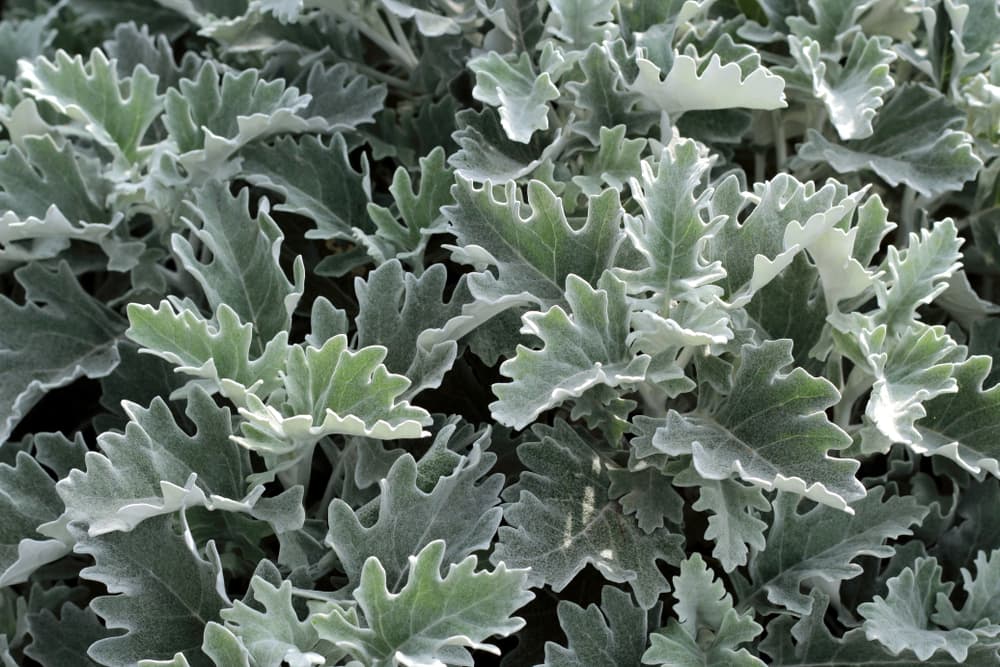
It has striking, silver-white leaves that look like they have been dusted with frost, which means that they stand out well against green shades of foliage, and help to add interest to pots, planters, beds or borders.
It is H4 hardy which means that it is hardy throughout much of the UK, and may well overwinter outdoors in a sunny, sheltered spot.
Though usually grown for their foliage rather than their flowers, these plants sometimes also have yellow, daisy-like flowers in summer.
Pericallis x hybrida
P. x hybrida are evergreen perennials which are also often grown as annuals in the UK.
They form low clumps of dark green foliage, and bear loose groups of bright coloured blooms over the summer months.
They are often H3 hardy and may overwinter successfully in a greenhouse, or in the mildest parts of the UK.
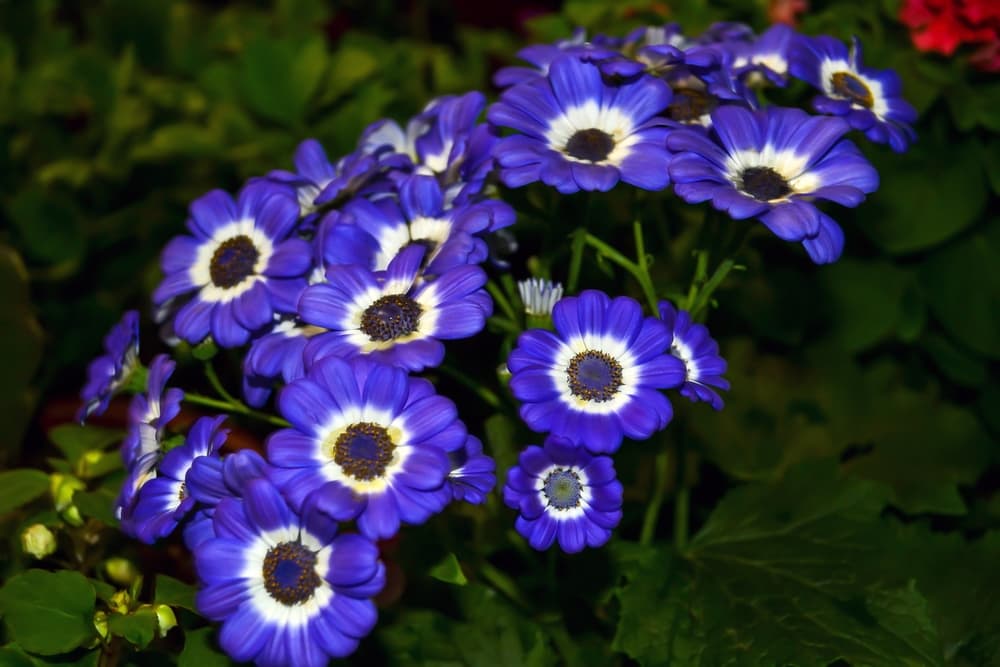
Their large daisy-like flowers can be very attractive in beds, borders or containers over the summer months, and come in many shades from blue, to purple, to pink, to red, to white – often with dark centres which can be in a different colour.
Often, these flowering plants are grown as temporary annual houseplants indoors or under cover.
Cineraria Types
When it comes to Cineraria, which type you will choose to grow will largely depend on where you plan to grow them.
Indoors, you will usually be looking at Pericallis ssp.
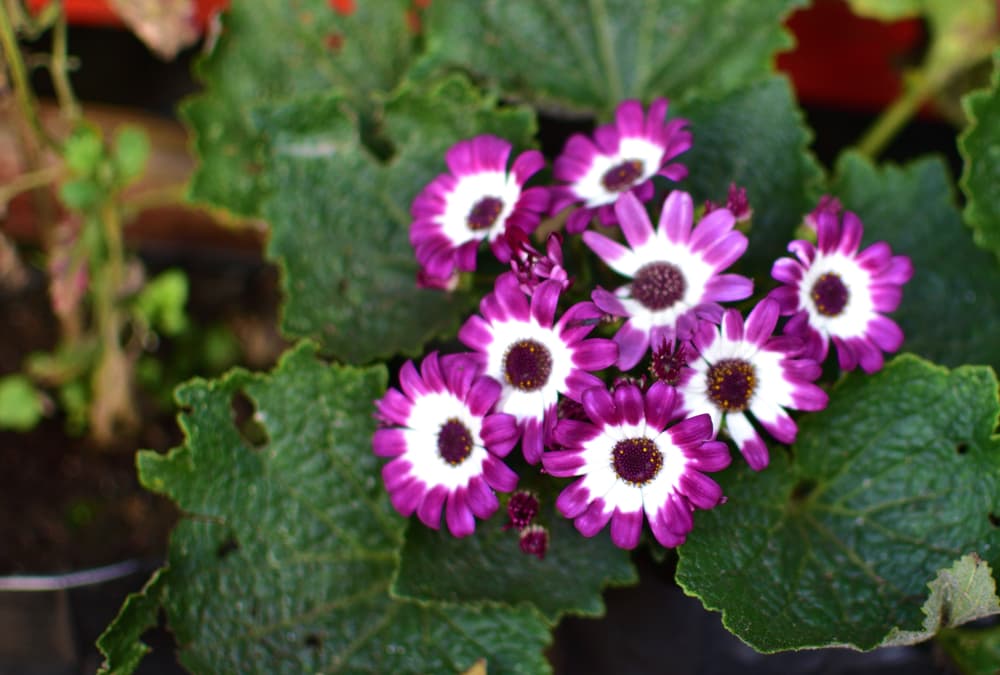
In your garden, these may still be an option, but less tender Senecio will perhaps be easier to grow outdoors.
If you are looking for a Silver Ragwort to grow, try ‘Silver Dust’ which has received the RHS Award of Garden Merit.

If you are looking at Florist’s cineraria, then the Senetti Series offers many of the most common choices. Some interesting named varieties are:
- ‘Jester Scarlet’
- ‘Magic Salmon’
- ‘Sunsenedibu’
- ‘Sunsenere’
- ‘Sunsenereba’
How To Grow Cineraria
Jacobaea maritima will grow well in any well-drained soil in sunny position, in pots or in the ground.
It works well for beds, planters or containers which face south or west, and can cope with drought and windy conditions, as well as a more sheltered spot.
P. x hybrida cineraria does best in full sun or partial shade; its tolerance to shade is one of the reasons which is why it can work well as a houseplant for the summer, as well as being grown outdoors as a pot plant or summer bedding plant.

It can thrive in any fertile, well-drained soil – though if you plan to overwinter your plants, they must be kept in a dry, cool, frost-free spot.
Growing From Seed
S. cineraria or Jacobaea maritima seeds should be sown in spring, between March and May at 19-24°C for optimal germination rates.
You can also take semi-ripe cuttings of these plants in the mid-late summer, or purchase plants from your local garden centre or plant nursery if you prefer.
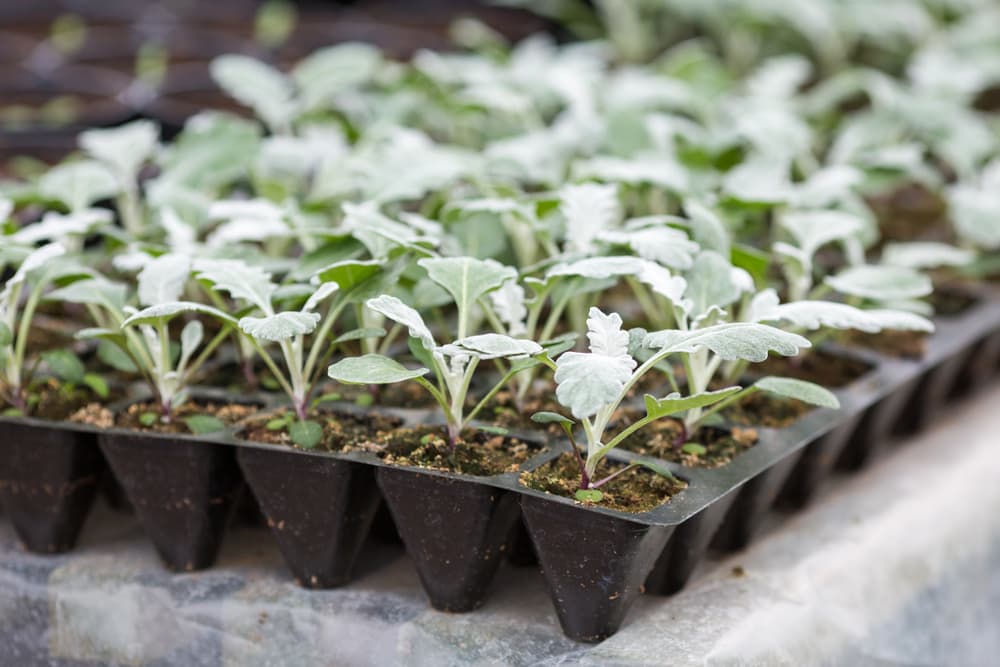
Plant out in beds or containers in May or June.
In milder areas, it may overwinter outside as mentioned, but you may prefer to grow it as an annual, or grow it in containers which can be moved indoors in autumn when frost threatens.
P. x hybrida cineraria seeds are sometimes sown in December, but when grown indoors, the seeds can be sown any time throughout the year.
The seeds are very small and are pressed into the surface of the potting mix or growing medium.
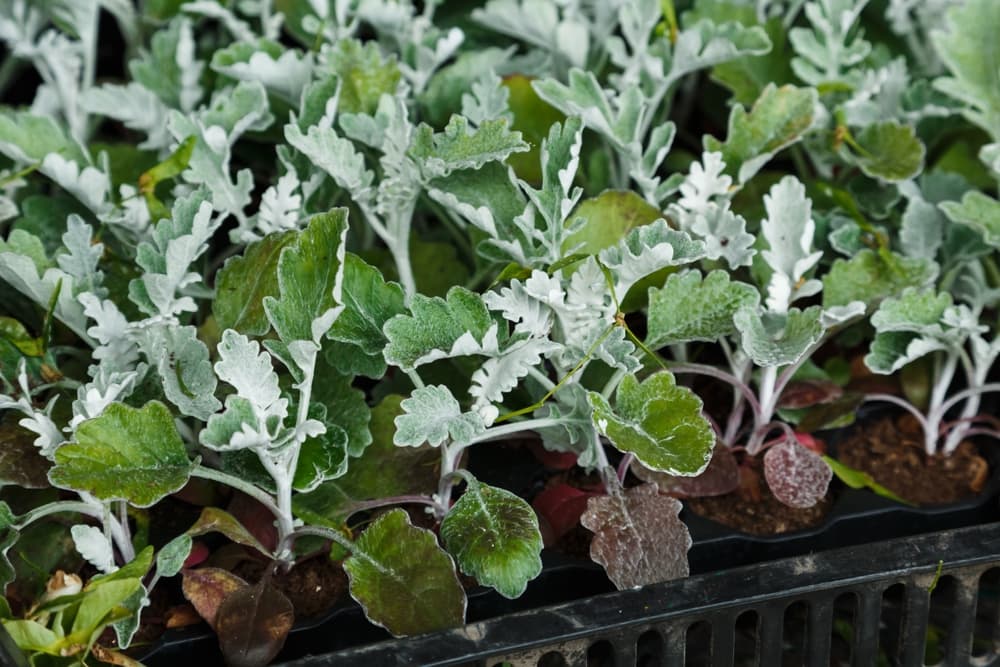
They are best sown in a propagator, and provided with temperatures of 18-20°C.
Shoots appear around two weeks after sowing, and seedlings are then potted up and should be kept at around 15°C for best results.
These plants can also be propagated by means of semi-ripe cuttings in mid-late summer.
Planting Out
You can also, of course, take the easy option and purchase bedding plants.
Whether you sow or propagate your own plants, or buy your Cineraria, again, you should plant them out in May or June.
Treat them as annuals or overwinter them as above in a dry and frost-free place as mentioned above.
However, it is worth noting that these Cineraria rarely bloom more than once, and so they do not make great perennials in most UK gardens and are best treated as annuals.
Cineraria Plant Care
J. maritima is a fairly easy plant to grow in containers or in your garden and it is an ornamental plant that we’d definitely recommend.
In order to encourage the plants to put on plenty of new foliage growth, it is generally best to cut back any long shoots to suppress flowering – since the foliage is the main decorative feature you are after.

Florist’s cineraria are beautiful flowering plants, no doubt, but they are short-lived and will take a lot more work.
If bought as bedding plants, it is worth noting that this can be an expensive option – and not the most sustainable choice.
These flowers can be finicky – requiring just the right light levels, amount of water, humidity etc. and only providing blooms in summer (or other seasons when grown indoors) for a relatively short length of time.
Common Problems
Cineraria can also be plagued by a range of pests and problems:
- Cineraria are beloved by aphids, thrips and whiteflies.
- Spider mites are also a common issue.
- Fungal issues such as mildews, root rot and common rust can also commonly occur.
In your garden, be sure to maintain a balance in the garden ecosystem with as much biodiversity as possible.

Use companion plants and attract beneficial predators to help you keep pest numbers down – for example, marigolds can work well as shown above.
Indoors, organic sprays can be used as a last resort to tackle extreme pest problems – neem oil, or biological controls can be considered, for example.
For home growers, there are better choices perhaps, than these fussy flowers, but many still love to grow them for their beautiful blooms.
